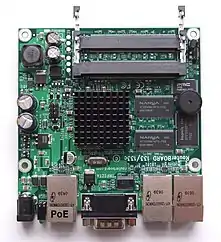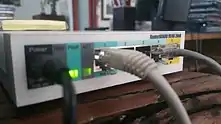MikroTik
MikroTik (officially SIA "Mikrotīkls") is a Latvian network equipment manufacturer. The company develops and sells wired and wireless network routers, network switches, access points, as well as operating systems and auxiliary software. The company was founded in 1996 with the focus of selling equipment in emerging markets. As of August 2019, the company website reported more than 280 employees. In 2015, with a revenue of EUR 202M, Mikrotik was the 20th largest company in Latvia.[2]

 | |
| Industry | Information Technology |
|---|---|
| Founded | 1996 |
| Headquarters | Latvia: Riga |
Key people | John Tully (CEO) Arnis Riekstiņš (CTO) |
| Products | routers, firewalls, software (RouterOS) |
Number of employees | 280 (2019)[1] |
| Website | mikrotik.com |
Products
MikroTik's product line comprises end-user networking devices, such as routers, switches, and access points, as well as boards without enclosures, and router software.
The features of MikroTik hardware are not restricted by software licensing; every device is capable of using every compatible feature. Customers may select hardware based solely on physical requirements, such as port density, processing power, number of wireless antennae, etc. Like other customized operating systems, driver software must be custom developed and Mikrotik products sometimes lag behind other manufacturers in this aspect.
RouterBOARD

RouterBOARD is a hardware platform from MikroTik, which is a line of routers running the RouterOS operating system. The various RouterBOARD options provide for a variety of application scenarios, from running wireless access points and managed network switches to firewall appliances with quality of service (QoS) features.
Almost all models of RouterBOARD devices can be powered by passive power over Ethernet (PoE), and have a connector for an external power source; a handful support standard 802.3af/at PoE.
Device models designed to work with wireless technologies have a miniPCI / miniPCIe slot for radio modules. Most models also have a connector for serial port access.

Consumer models
- hEX and hAP, entry level SOHO routers.
- Audience, access-point featuring mesh topology.
- Chateau LTE12, multipurpose SOHO router with LTE.
- mAP, small-factor access points.
- cAP, access points for ceiling mounting.
- wAP, access points for wall mounting.
- PWR-LINE, devices with Power-line communication capabilities.
Telecommunications models
- RB, CCR, CRS and CSS, mid to high-end rack-mounted routers and switches, with Ethernet, SFP and wireless connectivity.
- PowerBox and FiberBox, outdoor wired routers for Ethernet and SFP with PoE out.
- netPower, high density outdoor wired switches with PoE-out.
- OmniTIK, outdoor access points with built-in omni antenna.
- SXT, SEXTANT and DISC, wireless CPE devices for backbone with built-in directional antenna.
- mANTBox, oudoor base station with built-in directional antenna.
- Cube Lite60, outdoor point-to-multipoint CPE for high-density environments in small factor and 60 GHz frequency.
- LHG, DynaDish and Wireless Wire, outdoor point-to-point CPE for long distances with built-in parabolic antenna.
- LDF, outdoor point-to-point CPE for long distances, for use within standard parabolic TV antennas.
- BaseBox, NetBox and NetMetal, multipurpose outdoor wireless devices with RP-SMA connectors, to be used with mANT or third-party antennas.
- Groove and Metal, multipurpose outdoor wireless devices in bullet format, to be used within omni or yagi antennas without pigtails.
- LtAP, all-in-one access point, LTE and GPS devices for moving vehicles.
RouterOS
RouterOS is a network operating system based on Linux. Most RouterBOARD devices comes with RouterOS preinstalled. It is also available for installation on X86 and ARM devices (like a PC). In addition, Mikrotik offers cloud-oriented images called "Cloud Hosted Router" (CHR), to be used in virtual machines.
RouterOS may be configured through a command line interface accessible by serial port, telnet, and Secure Shell (SSH), and through a graphical user interface available as a web-based interface (WebFig), a Microsoft Windows-based software application (Winbox), and iOS and Android apps. An application programming interface (API) permits the development of specialized applications for monitoring and management.
Major versions
- RouterOS v7 beta: October 2019 (based on Linux kernel 5.6.3).
- RouterOS v6: May 2013 (based on Linux kernel 3.3.5).
- RouterOS v5: March 2011 - September 2013 (based on Linux 2.6.35 kernel)
- RouterOS v4: October 2009 - March 2011 (based on Linux 2.6.26 kernel)
- RouterOS v3: January 2008 - October 2009 (based on Linux 2.4.31 kernel)
Licensing model
RouterOS is distributed free for charge. However, features are implemented in a paid, level licensing model.[3] Each RouterBOARD device comes with RouterOS preinstalled within a specific license according to the offered features.
- 0 (24 hour trial): all features enabled, to be tested within a period of 24 hours. Before expiring the trial, the user must install a valid license.
- 1 (free demo): most features enabled (except routing and wireless), limited to one instance of each. A license key is required (free for charge).
- 3 (WISP CPE): present in RouterBOARD CPE wireless client (point-to-point/multipoint) models, but lacks of access point features. It is not commercially available as a separated product.
- 4 and 5 (WISP): all the features enabled, limited to 200 and 500 instances of each, respectively. Present in low to mid-end RouterBOARD devices. Its sale price is US$45 and US$95 respectively.
- 6 (controller): all the features, unlimited. Present in high-end RouterBOARD devices. Its sale price us US$250.
The licensing model for Cloud Hosted Router is the following:
- free: limited to 1 Mb/s per interface. No license key required.
- 60 day trial without limitations, but requires a license key (free for charge).
- p1: perpetual license, limited to 1 Gb/s. Its sell price is US$45.
- p10: perpetual license, limited to 10 Gb/s per interface. Its sale price is US$90.
- p-unlimited: perpetual license, without bandwidth limits. Its sell price is US$250.
The CHR licensing model offers all the features without further restrictions, and is limited to one VM instance per license.
SwOS
SwOS is an operating systems for RouterBOARD switches. It is based on a subset of features of RouterOS.
Product vulnerabilities
On 23 May 2018, Cisco Talos Intelligence Group reported that some MikroTik devices were found vulnerable to the VPNFilter malware.[4][5][6] MikroTik routers have been compromised by Coinhive cryptocurrency malware.[7]
Product acceptance
For market support, the company has established a network of resellers and training associates who issue varies certifications to industry professionals. [8][9]
MikroTik products have found acceptance in various market niches. They are popular in do-it-yourself (DIY) projects for computer networking and in low budget applications.[10]
Patron of the University of Latvia
MikroTik is a platinum patron of the University of Latvia Foundation. Has been supporting the University of Latvia since 2011, when the company donated two sets of MikroTik routers with a wide range of functionality to the Faculty of Computer Science of the University of Latvia. At the end of 2015, SIA MikroTik donated EUR 500,000 for the implementation of projects of the University of Latvia, Faculty of Computer Science (DF), Faculty of Physics, Mathematics and Optometry (FMOF), as well as the Faculty of Medicine (MF). In 2016, SIA MikroTik donated 1,000,000 EUR, continuing cooperation with the LU Foundation in the development of higher education, science and culture. At the end of 2017, SIA "Mikrotīkls" donated 250,000 EUR to further develop the field of exact, life and medical sciences at the University of Latvia. In 2018, the University of Latvia continue to support the development of natural sciences, life and medical sciences by donating 250,000 euros. In 2019, 400,000 EUR was donated for the implementation of various projects.[11]
References
- MikroTik - About us, MikroTik
- "Tirgoties izdevīgāk nekā ražot". LA.lv.
- Burgess, Dennis (2011). Learn RouterOS (2 ed.). p. 26. ISBN 978-1-105-06959-8.
- "New VPNFilter malware targets at least 500K networking devices worldwide". Talos Threat Source Newsletter. 2018-05-23.
- Lucero II, Louis (2018-05-27). "F.B.I.'s Urgent Request: Reboot Your Router to Stop Russia-Linked Malware". The New York Times.
- Godin, Dan (2018-05-23). "Hackers infect 500,000 consumer routers all over the world with malware". Ars Technica. Retrieved 2019-04-21.
- Nichols, Shaun (2018-08-03). "MikroTik routers grab their pickaxes, descend into the crypto mines". The Register. The Register. Retrieved 2019-04-21.
- Discher, Stephen (2016). RouterOS by Example (2 ed.). ISP Services, Inc.
- Hart, Tyler (2017-11-04). Networking with MikroTik: MTCNA Study Guide. Independently published. ISBN 978-1973206354.
- Flickenger, Rob; Weeks, Roger (2006). Wireless Hacks (2 ed.). O'Reilly Media, Inc. p. 201.
- https://www.fonds.lv/lepojamies/mecenati/platina-mecenati/mikrotikls/
External links
- Company website (in English)